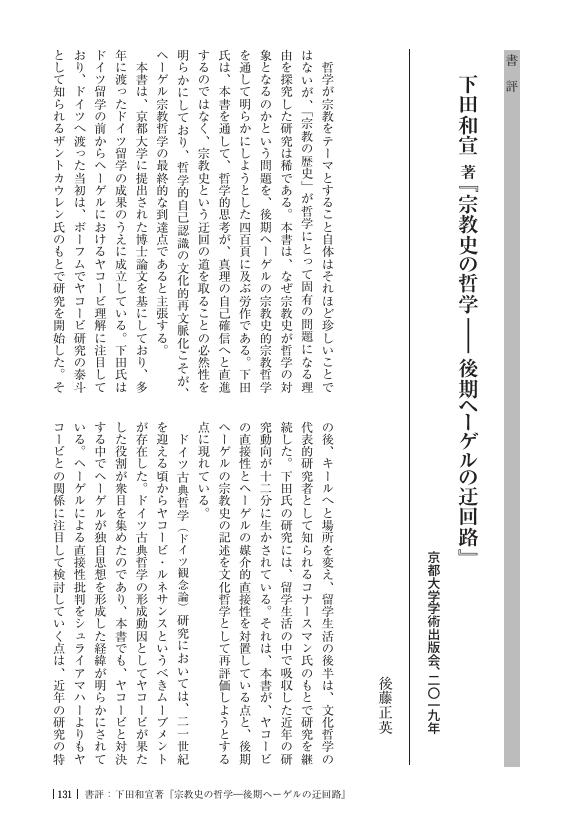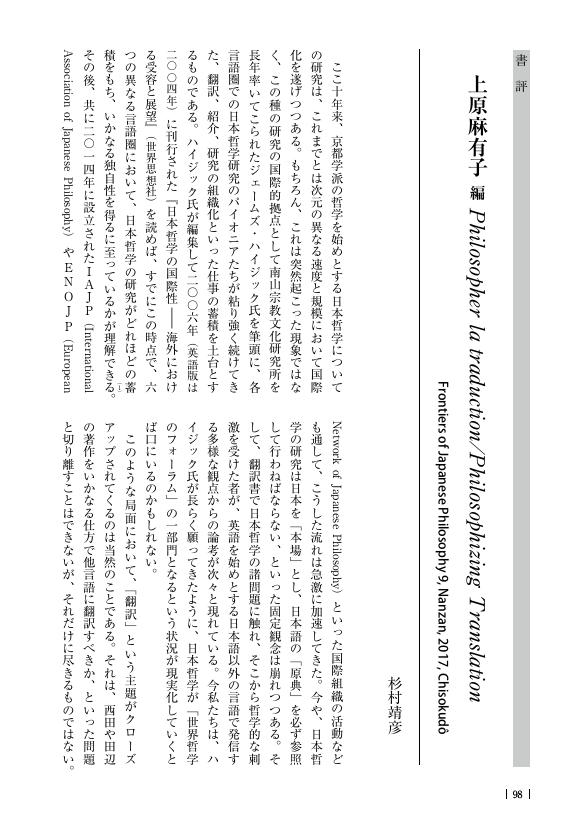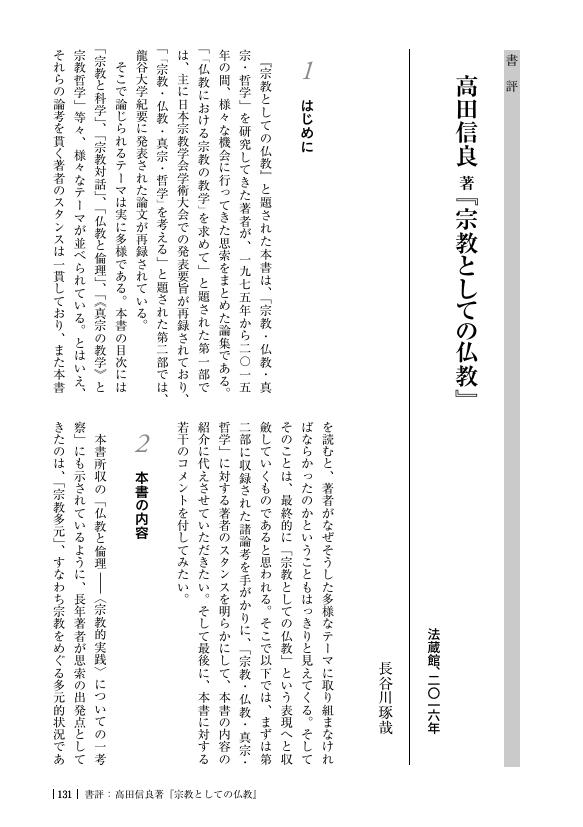1 0 0 0 OA 永井晋著『〈精神的〉東洋哲学―顕現しないものの現象学』
- 著者
- 丸山 空大
- 出版者
- 宗教哲学会
- 雑誌
- 宗教哲学研究 (ISSN:02897105)
- 巻号頁・発行日
- vol.37, pp.123-126, 2020-03-31 (Released:2020-07-09)
1 0 0 0 OA 松井吉康著『存在の呪縛』
- 著者
- 神尾 和寿
- 出版者
- 宗教哲学会
- 雑誌
- 宗教哲学研究 (ISSN:02897105)
- 巻号頁・発行日
- vol.37, pp.127-130, 2020-03-31 (Released:2020-07-09)
1 0 0 0 OA 下田和宣著『宗教史の哲学―後期ヘーゲルの迂回路』
- 著者
- 後藤 正英
- 出版者
- 宗教哲学会
- 雑誌
- 宗教哲学研究 (ISSN:02897105)
- 巻号頁・発行日
- vol.37, pp.131-134, 2020-03-31 (Released:2020-07-09)
1 0 0 0 OA 谷口静浩著『ハイデッガーの思惟と宗教への問い―宗教と言語を巡って』
- 著者
- 松本 啓二朗
- 出版者
- 宗教哲学会
- 雑誌
- 宗教哲学研究 (ISSN:02897105)
- 巻号頁・発行日
- vol.37, pp.135-138, 2020-03-31 (Released:2020-07-09)
1 0 0 0 OA 浄土教の象徴的行為 親鸞の行論を探究する
- 著者
- 杉岡 孝紀
- 出版者
- 宗教哲学会
- 雑誌
- 宗教哲学研究 (ISSN:02897105)
- 巻号頁・発行日
- vol.37, pp.1-15, 2020-03-31 (Released:2020-07-09)
Although the relationship between nembutsu (or true practice) and shinjin (or true entrusting) is said to constitute the center of Shinran Pure Land Buddhism, research from the modern period up to the present has focused mainly on studies of shinjin. In recent years, there have been attempts to elucidate Shinran’s concept of shinjin using a psychological perspective on the Buddha’s teachings, or through the application of counseling theory, and this trend is growing stronger. There are very few new understandings and interpretations of Shinran’s Buddhist thought. However, from among these, I would like to focus on a unique perspective that views Buddhist thought in Shinran Pure Land Buddhism as a symbolic act. This paper discusses the understandings of the philosopher Yoshinori Takeuchi and the Shin Buddhist scholar Ryoji Oka. Their approaches are used to clarify the characteristics of Buddhist thought based on the 17th Amida’s vow in Shinran.
1 0 0 0 OA 戦争と狂熱 動機をめぐるカントの省察およびレヴィナスの意志論を手がかりとして
- 著者
- 末永 絵里子
- 出版者
- 宗教哲学会
- 雑誌
- 宗教哲学研究 (ISSN:02897105)
- 巻号頁・発行日
- vol.37, pp.43-55, 2020-03-31 (Released:2020-07-09)
Dans sa méditation sur les mobiles de l’action, Kant mentionne l’illusion nommée « exaltation morale (moralische Schwärmerei) ». Il s’agit d’une illusion qui touche au Bien suprême, qui sert de thème capital à l’Analytique de la raison pratique et constitue la première condition du souverain Bien dont traite la Dialectique de la raison pratique. Le but de cette étude consiste à expliciter la constitution de l’« expérience de la guerre » chez Lévinas en prenant pour horizon herméneutique cette « exaltation morale ». Notre objectif final est cependant de faire de ce travail d’explicitation le point de départ d’un parcours qui nous conduira à élucider quelles sont l’« expérience de la totalité » chez Lévinas et la « pathologie de la totalité » chez Ricœur. Dans notre perspective, le symptôme de la phase terminale de cette pathologie est ce qu’on pourrait nommer une apparence perverse, tandis que son premier symptôme en est une exaltation perverse. Tout d’abord, nous traitons de la violence qui fait problème sous le régime de la guerre moderne en résumant son essence comme apparence qu’il faudrait appeler l’autonomie subjective selon l’hétéronomie objective. Ensuite, nous montrons que l’« expérience de la guerre » chez Lévinas peut être entièrement comprise à partir de l’exaltation morale chez Kant. Finalement, nous explicitons la constitution de cette illusion au travers de l’analyse de la corporéité et de la mortalité de la volonté humaine chez Lévinas qui correspond au libre-arbitre (Willkür) chez Kant.
1 0 0 0 OA ウィリアム・ジェイムズにおける宗教的な経験と実在
- 著者
- 山根 秀介
- 出版者
- 宗教哲学会
- 雑誌
- 宗教哲学研究 (ISSN:02897105)
- 巻号頁・発行日
- vol.36, pp.57-70, 2019-03-30 (Released:2019-05-22)
In his Pragmatism and The Meaning of Truth, William James accounted for and developed his own theory of truth. For James, truth is the agreement of an idea with reality and this agreement has to be verified in our actual experience. From this point of view, reality means sensible experience. These notions about truth, reality and experience are not so difficult to understand as long as we deal with ordinary or scientific matters. However, are these concepts true of religious matters? Religious phenomena transcend our sensible experience, so people tend to think there is an essential difference between two kinds of experiences. In The Varieties of Religious Experience, James tries to reveal the nature of religious experience. James doesn’t think that these two experiences are completely different. He qualifies religious experience and reality as ‘quasi-sensible’, and this attitude isn’t incompatible with that of Pragmatism and The Meaning of Truth in which experience is considered to be sensible. The purpose of this paper is, by reading carefully The Varieties, to elucidate what the religious experience and reality are, focusing on what is meant by the adjective ‘quasi-sensible.’ For James, in religious experience, people are affected through their sensible experience by religious reality called ‘subliminal’ or ‘the more’, and so an individual consciousness turns out to be surrounded by the vast superhuman consciousness.
1 0 0 0 OA マルティン・ブーバーの聖書解釈 神話、悪、想像
- 著者
- 佐藤 貴史
- 出版者
- 宗教哲学会
- 雑誌
- 宗教哲学研究 (ISSN:02897105)
- 巻号頁・発行日
- vol.36, pp.71-83, 2019-03-30 (Released:2019-05-22)
This paper presents considerations on the significance of myth, evil, and imagination in the religious thought of the Jewish philosopher Martin Buber, as seen in his biblical hermeneutics. According to Claire E. Sufrin, a scholar of modern Jewish thought and theology, Buber chose the term “saga,” not “myth,” in his hermeneutics. This paper, however, clarifies that myth—not only the term but also its meaning—played an important role in Buber’s hermeneutics. In looking at Genesis, Buber took up the stories of the Tree of Knowledge and the Flood and argued that these describe in mythical form the essence of the problem of evil. This paper explains that Buber’s biblical hermeneutics was mythological to a great extent, which indicates that, contrary to Sufrin’s claim, Buber placed tremendous importance on myth. Further, according to Buber, evil was the product of human imagination, and in that sense, it had its origin not in God but in humankind. For Buber, the Bible as a myth described “the human constitution and movement of evil.” This paper clarifies that in Buber’s biblical hermeneutics, myths—especially those concerning the problem of evil—have great significance.
- 著者
- 杉村 靖彦
- 出版者
- 宗教哲学会
- 雑誌
- 宗教哲学研究 (ISSN:02897105)
- 巻号頁・発行日
- vol.36, pp.98-101, 2019-03-30 (Released:2019-05-22)
1 0 0 0 OA 岡村康夫著『シェリング哲学の躓き―『世界時代』の構想の挫折とその超克』
- 著者
- 神尾 和寿
- 出版者
- 宗教哲学会
- 雑誌
- 宗教哲学研究 (ISSN:02897105)
- 巻号頁・発行日
- vol.36, pp.111-114, 2019 (Released:2019-05-22)
1 0 0 0 OA 竹村牧男著『井上円了―その哲学・思想』
- 著者
- 長谷川 琢哉
- 出版者
- 宗教哲学会
- 雑誌
- 宗教哲学研究 (ISSN:02897105)
- 巻号頁・発行日
- vol.36, pp.115-119, 2019-03-30 (Released:2019-05-22)
1 0 0 0 OA チャールズ・テイラーの認識論と宗教史 「身体」をめぐって
- 著者
- 坪光 生雄
- 出版者
- 宗教哲学会
- 雑誌
- 宗教哲学研究 (ISSN:02897105)
- 巻号頁・発行日
- vol.35, pp.104-117, 2018-03-31 (Released:2018-05-11)
In this article, we explore the point on which Charles Taylor’s two independent arguments converge. The historical account of religion in A Secular Age on the one hand and the philosophical criticism of modern epistemology in Retrieving Realism on the other have in common the insight that the body is essential for us. In A Secular Age, Taylor shows how the work of Reform and its consequent effect of disenchantment have sidelined the bodily, sensual aspects of earlier religious life. He insists on the need to undo this “disenchanting reduction” and rehabilitate the body in religion today. Parallel to this is the deconstruction of the modern epistemology which presupposes the inner-outer distinction, that is, the clear boundary between mind and body, as well as mind and world. Retrieving Realism makes clear that our belief formations are always already conditioned by our bodily, preconceptual engagement with our ordinary surroundings. The inner-outer dualism of modern epistemology needs to be overcome because it leaves no place for this preconceptual level of our perception, or even our embodied existence in general. We can obviously see Taylor’s consistency here. Retrieving the sense of embodiment is a central concern for him both as a historian of religion and as an analytic philosopher.
1 0 0 0 OA 布施圭司著『ヤスパース 交わりとしての思惟―暗号思想と交わり思想』
- 著者
- 若見 理江
- 出版者
- 宗教哲学会
- 雑誌
- 宗教哲学研究 (ISSN:02897105)
- 巻号頁・発行日
- vol.35, pp.118-121, 2018-03-31 (Released:2018-05-11)
1 0 0 0 OA 澤井義次著『シャンカラ派の思想と信仰』
- 著者
- 小田 淑子
- 出版者
- 宗教哲学会
- 雑誌
- 宗教哲学研究 (ISSN:02897105)
- 巻号頁・発行日
- vol.35, pp.122-125, 2018-03-31 (Released:2018-05-11)
1 0 0 0 OA 華園聰麿著『宗教現象学入門―人間学への視線から』
- 著者
- 高田 信良
- 出版者
- 宗教哲学会
- 雑誌
- 宗教哲学研究 (ISSN:02897105)
- 巻号頁・発行日
- vol.35, pp.126-130, 2018-03-31 (Released:2018-05-11)
1 0 0 0 OA 高田信良著『宗教としての仏教』
- 著者
- 長谷川 琢哉
- 出版者
- 宗教哲学会
- 雑誌
- 宗教哲学研究 (ISSN:02897105)
- 巻号頁・発行日
- vol.35, pp.131-134, 2018-03-31 (Released:2018-05-11)
1 0 0 0 OA 星川啓慈著『宗教哲学論考―ウィトゲンシュタイン・脳科学・シュッツ』
- 著者
- 佐藤 啓介
- 出版者
- 宗教哲学会
- 雑誌
- 宗教哲学研究 (ISSN:02897105)
- 巻号頁・発行日
- vol.35, pp.135-138, 2018-03-31 (Released:2018-05-11)
1 0 0 0 OA 聖土曜日における人間 不在からの考察
- 著者
- 寺尾 寿芳
- 出版者
- 宗教哲学会
- 雑誌
- 宗教哲学研究 (ISSN:02897105)
- 巻号頁・発行日
- vol.36, pp.14-28, 2019-03-30 (Released:2019-05-22)
The relation of the dead and the living is examined against the background that the contemporary Christian faith is not a process of mastering the ready-made doctrines, but a personal experience of looking for the true life of Christ. Here, the most important emphasis is put on the mourning work by the living person with repentance for the absent deceased loved one. The idea of Holy Saturday in the Paschal Mystery provides us an instructive point of view. The Easter Triduum can be radically found in the whole of time and sanctifies and moves our chronological time forward. Particularly on the second day, Holy Saturday, when the Lord descended to the dead according to the Apostles’ Creed, the Church essentially refrains from any kind of the ecclesiastical liturgy. Then the illumination of revelation on the living people decreases, as the Lord is absent, and their sinful visage becomes apparent in contrast. The self-inquiry on that day illuminates that the living people are responsible for the death of the deceased in the historical-social stage and it forms a necessary part of the mourning work here. Once the living fulfill the responsibility of being conscious of their sins, they can acceptably expect the resurrection of the dead. But the burden of such self-inspection is likely to be so heavy that in order to accomplish it we, as living ones, need to take as our model someone such as Oshida Shigeto, who was thoroughly honest to the radical evil in him.
1 0 0 0 OA 宗教哲学にとっての脳神経科学の意義
- 著者
- 芦名 定道
- 出版者
- 宗教哲学会
- 雑誌
- 宗教哲学研究 (ISSN:02897105)
- 巻号頁・発行日
- vol.35, pp.1-12, 2018-03-31 (Released:2018-05-11)
The purpose of this paper is to rearrange the discussions about what the significance of neuroscience, which is currently rapidly developing, for philosophy of religion has and then to prospect the possibility of neuroscience in relation to philosophy of religion. First of all, our discussion begins after confirming that philosophy of religion understood in this paper includes both philosophy of religious studies and philosophy of religion. The following development of neuroscience is interesting in terms of overcoming the conflict between science and religion. 1. Studies on individual brains remarkable in the neuroscience by the end of the 20th century have shown approaches to the conflict schema between science and religion in the setting of determinism versus free will. 2. On the other hand, social brain research since the beginning of the 21st century shows the possibility of development of a different argument from the conflict schema. This social brain research could be interpreted as responding to the development of the philosophical anthropology of the 20th century and furthermore it provides an opportunity to reconsider the human understanding of Christianity.
1 0 0 0 OA 宗教研究は脳科学・認知科学の展開にどう向かいあうか
- 著者
- 井上 順孝
- 出版者
- 宗教哲学会
- 雑誌
- 宗教哲学研究 (ISSN:02897105)
- 巻号頁・発行日
- vol.35, pp.28-46, 2018-03-31 (Released:2018-05-11)
Neuroscience and cognitive science have undergone explosive advances since the 1990s, the effects of which have even been felt on religious studies. I will explore here what new perspectives these developments might generate by looking at two specific issues. The first is that of what concepts of kami (deity), imi (taboo) and kegare (pollution) exist in modern Shinto. The second is connected to research concerning the debate over the nature of the founders of new religions and the process by which people adopt those faiths. The question of what is distinctive about the kami concept in Shinto can be seen as part of the broader question of what leads the human mind to conceive of gods and deities in the first place. Similarly, such common Shinto ideas as imi and kegare come under the broader topic of why humans establish taboos for certain acts and behaviors. While discussing prior research, I also stress the need to study these new perspectives. Max Weber’s theory of charisma is widely used in discussions regarding the founders of new religions, but I believe that the phenomenon of people becoming entranced with a certain person can be examined from a broader perspective that incorporates neuroscience. The same may be said for the conversion process.











